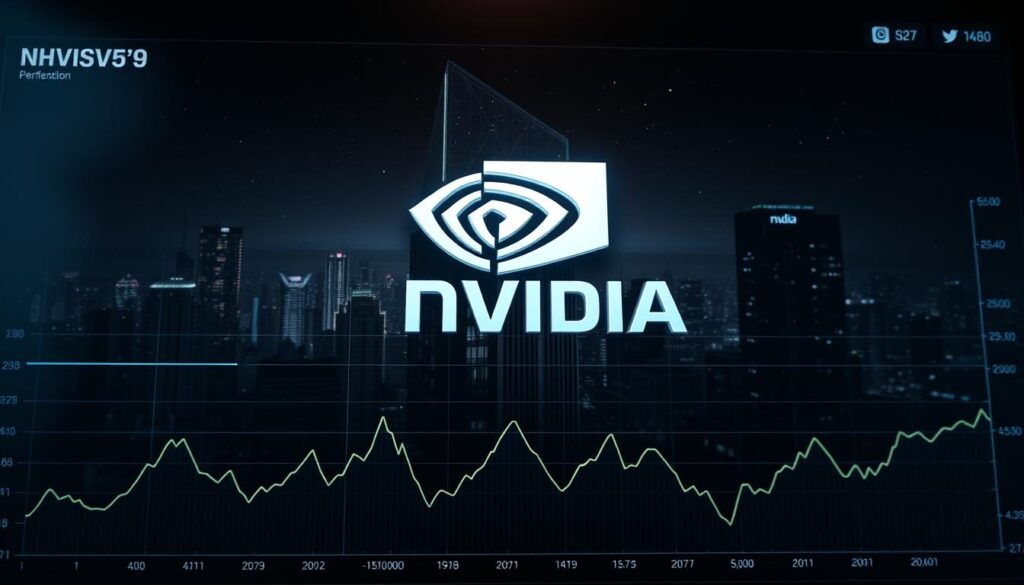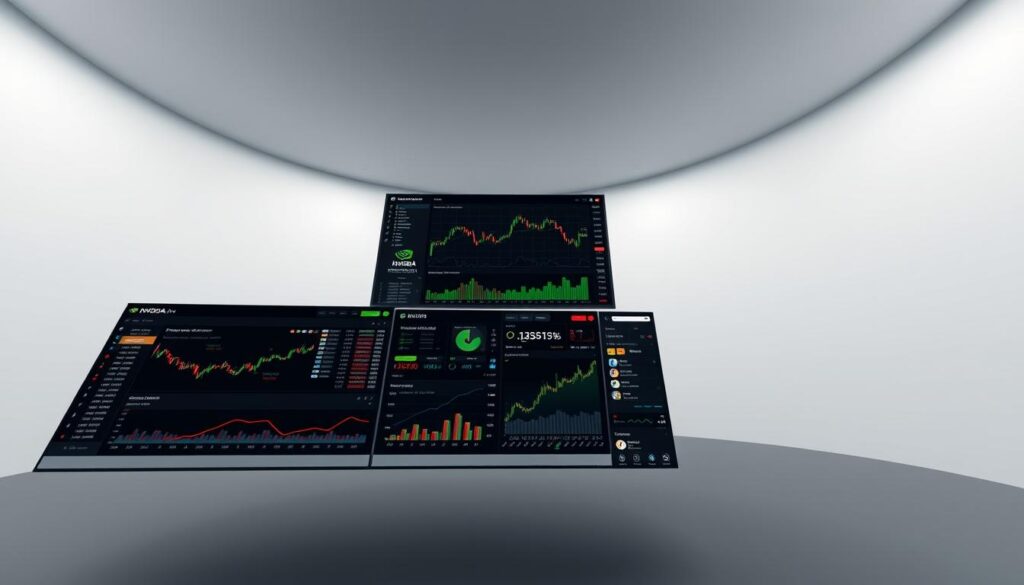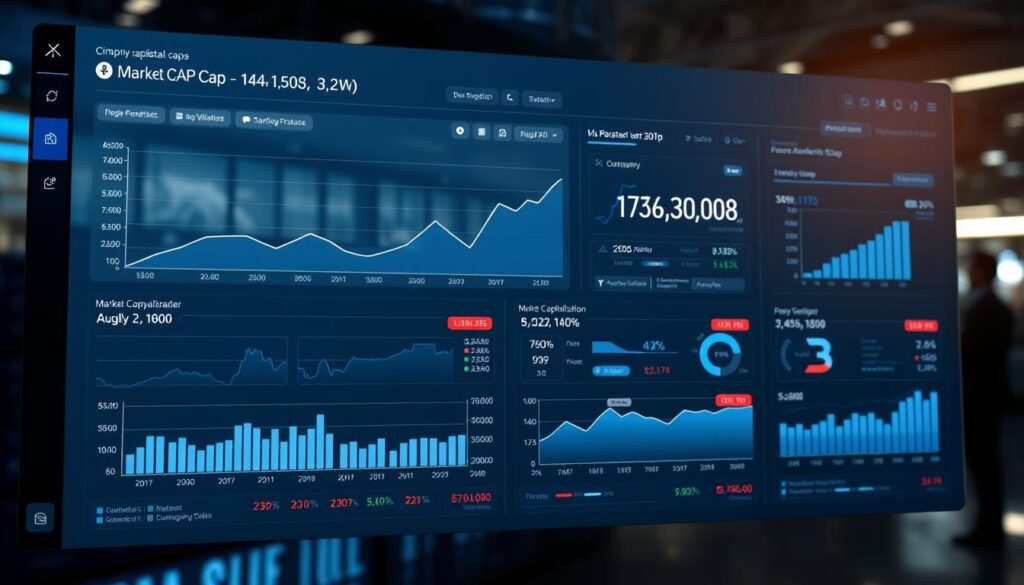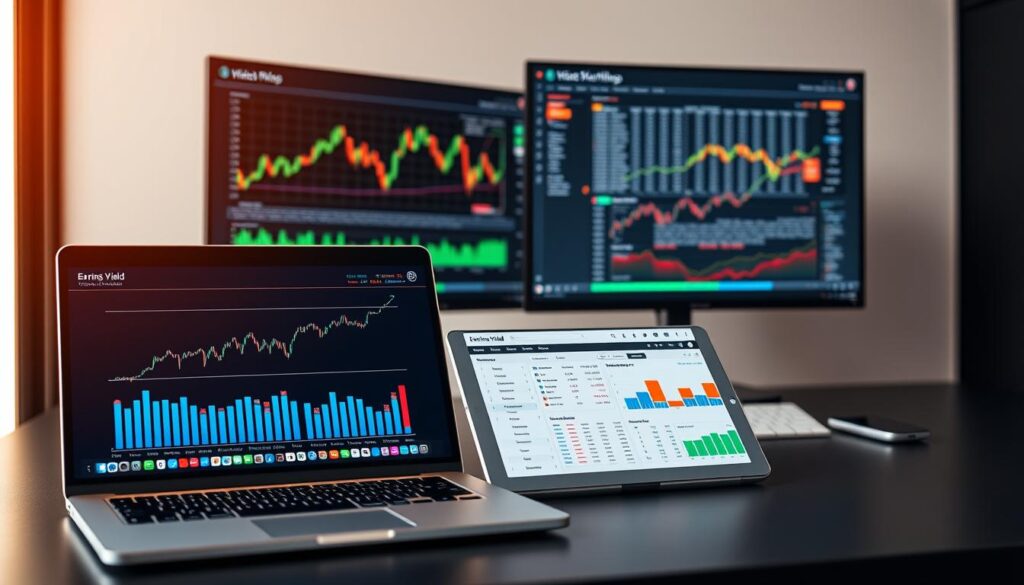Tech investors and traders increasingly rely on advanced platforms to track high-performance equities. One standout example is the semiconductor giant valued at $4.24 trillion, whose shares recently climbed to $174.25 amid growing demand for AI infrastructure. This company’s 54% annual growth reflects its pivotal role in shaping modern computing.
The right analytical resources can make all the difference when evaluating such dynamic equities. Platforms offering real-time data visualization and customizable technical indicators empower users to spot trends faster. These tools prove especially valuable for monitoring volatility in fast-moving sectors like artificial intelligence hardware.
Understanding market sentiment remains crucial for navigating tech investments. Volume patterns, price action, and institutional activity often reveal hidden opportunities. By combining fundamental analysis with live charting features, traders gain a clearer picture of potential entry and exit points.
This guide explores practical strategies for leveraging these technologies effectively. Readers will discover how to interpret critical metrics while staying ahead in today’s competitive markets. The focus remains on actionable insights rather than speculative predictions.
Overview of NVIDIA TradingView Charts & Analysis Tools
In today’s fast-paced markets, having the right tools is crucial for tracking high-growth technology equities. The semiconductor sector leader, founded in 1993 and headquartered in California, operates through three core divisions: GPU development, Tegra processors, and specialized computing solutions. These segments power everything from gaming systems to AI infrastructure, reflecting its $4.24 trillion market capitalization dominance.
Advanced charting platforms provide essential features for evaluating such complex businesses. Traders access multiple timeframes and customizable technical indicators to assess price movements across different chart types. Real-time synchronization across devices ensures investors never miss critical updates, whether analyzing candlestick patterns or volume trends.
The platform’s social features enable knowledge-sharing among global traders. Users discuss strategy adjustments and sector news while monitoring key metrics like earnings surprises and dividend yields. This combination of technical analysis and community insights helps investors navigate the semiconductor leader’s unique market position effectively.
With cloud-based architecture, these tools adapt to various skill levels while maintaining professional-grade precision. Investors gain clearer perspectives on entry points and risk factors through integrated financial data and visualizations. Such resources prove invaluable when assessing companies driving technological innovation.
Understanding NVIDIA Stock Performance

Market participants dissecting high-growth tech stocks must consider decades-long trajectories. The semiconductor leader’s shares surged 54.15% year-over-year, peaking at $174.25 in July 2025. This contrasts sharply with its 1999 low of $0.03, reflecting its evolution from graphics specialist to AI powerhouse.
Recent weekly gains of 0.48% and monthly jumps of 16.88% highlight ongoing momentum. These movements often align with AI breakthroughs and shifts in cryptocurrency mining demand, which historically drove GPU sales. Investors track these patterns to anticipate price fluctuations in volatile markets.
The stock’s beta coefficient of 2.30 signals heightened sensitivity compared to stable blue-chip stocks. Earnings reports and product launches frequently trigger 5-10% daily swings. Such volatility demands tools that map real-time data against historical benchmarks.
Macroeconomic factors add complexity. Interest rate changes and semiconductor supply chain disruptions disproportionately impact this sector. Traders monitor these variables alongside company-specific news to gauge risk-reward balances.
Platforms offering multi-layered analysis help decode these dynamics. Users assess how AI adoption rates or geopolitical events might affect future stocks performance. This approach transforms raw data into actionable insights for tech-focused portfolios.
Key Features of TradingView Charts for NVIDIA

Sophisticated charting tools transform how investors interact with market data, particularly for high-volatility equities. These platforms combine granular tracking with multi-decade perspectives, helping traders navigate securities with beta coefficients above 2.0. Three core functionalities stand out for analysing growth-oriented technology shares.
Real-Time Price Trends
Live updates refresh every 2-3 seconds during market hours, capturing sudden moves in volatile stocks. Custom alerts trigger when shares breach predefined price thresholds or exhibit unusual volume spikes. This proves critical given the security’s 1.02% daily volatility and tendency for 5% intraday swings.
Historical Data Insights
Analysts overlay weekly candlesticks against quarterly performance charts to spot recurring patterns. The platform stores 25+ years of trading data, revealing how this stock behaved during dot-com crashes and AI adoption surges. Users test strategies against historical benchmarks while monitoring the $100-$250 analyst target range.
Advanced drawing tools let traders map Fibonacci levels adjusted for the security’s unique risk profile. Correlation matrices compare sector movements against key financial events, turning raw data into actionable intelligence.
Analyzing Technical Indicators and Patterns

Technical analysis serves as the cornerstone for evaluating fast-moving equities. Current signals show a strong buy rating across daily, weekly, and monthly timeframes. This alignment suggests sustained momentum, particularly when paired with historical pattern recognition.
Moving Averages and RSI
The 20-day moving average recently crossed above the 200-day benchmark, signaling bullish momentum. Traders watch these intersections closely, as they often precede extended rallies. Meanwhile, the Relative Strength Index sits at 62 – comfortably below overbought thresholds while indicating upward pressure.
Trend and Momentum Signals
MACD histograms display widening positive bars, reinforcing the current uptrend. Bollinger Band contractions suggest impending volatility spikes, common during earnings announcements. Stochastic oscillators hover near 80, reflecting strong buying activity without reaching extreme levels.
Chart patterns like ascending triangles have emerged three times since 2023, each followed by 15-20% price jumps. Custom indicator settings account for the security’s 2.3 beta rating, filtering out market-wide noise. These tailored approaches help traders distinguish genuine signals from temporary fluctuations.
Volume analysis completes the picture. Recent accumulation days – where price gains coincide with above-average trading activity – reinforce the bullish technical outlook. Such multi-indicator confirmation helps investors act decisively in dynamic markets.
In-Depth Market Capitalization and Financial Metrics

Financial metrics reveal operational strengths better than any mission statement. The semiconductor leader’s $4.24 trillion market capitalization positions it among history’s most valuable enterprises. This valuation reflects confidence in artificial intelligence infrastructure development and sustainable profit growth.
Revenue, Net Income, and EBITDA Overview
Annual revenue reached $130.50 billion, demonstrating mastery across gaming and data center markets. Profit margins tell a sharper story: $72.88 billion net income translates to industry-leading efficiency. Investors note the 63.85% EBITDA margin – nearly double typical tech sector benchmarks.
Employee productivity metrics underscore operational excellence. Each worker generates $3.62 million in revenue, outperforming rivals by wide margins. This capital-efficient model fuels reinvestment in next-generation technologies while maintaining shareholder returns.
Analysts correlate these fundamentals with technical patterns to assess valuation合理性. Platforms integrating real-time financial data help traders identify when stocks diverge from business performance. Such tools prove vital given the company’s influence on broader market indices.
While dividend yield remains modest compared to value-oriented firms, growth-focused investors prioritize expansion potential. The combination of scale and innovation keeps this equity central to discussions about technological disruption.
Evaluating Earnings and Dividend Insights

Financial disclosures often serve as critical checkpoints for growth-focused investors. Recent quarterly results revealed a 9.89% earnings surprise, with $0.81 per share outperforming $0.74 estimates. This pattern of exceeding expectations highlights operational agility in capitalising on AI infrastructure demand.
Quarterly Earnings Surprises
Consistent outperformance stems from strategic positioning in high-growth markets. Last quarter’s $44.06 billion revenue surpassed projections by $730 million, driven by data center solutions. Upcoming August reports could trigger volatility, creating potential buying opportunities for alert traders.
Dividend Yield Trends
The 0.02% yield reflects prioritisation of innovation over income distribution. While $0.01 quarterly payments seem modest, they signal confidence in sustained profit generation. This approach preserves capital for R&D investments while maintaining shareholder goodwill.
Analysts monitor these metrics to assess balance between growth and returns. Platforms integrating earnings calendars help traders anticipate price swings around financial announcements. Such tools prove vital when navigating equities with significant event-driven volatility.
Impact of AI Advances and 2025 Catalysts on NVIDIA

Artificial intelligence breakthroughs are reshaping industries, creating ripple effects across global markets. Analysts project a $2 trillion AI sector expansion by 2027, with semiconductor innovators positioned to capture significant value. Wedbush’s Daniel Ives highlights this 2025 catalysts cycle as pivotal, noting how enterprise adoption and infrastructure upgrades could drive sustained growth.
The B200 AI chip’s shadow market presence underscores intense demand. Over $1 billion worth entered China despite trade restrictions, selling at 30-40% premiums. This underground activity signals persistent appetite for advanced processing power, particularly in autonomous systems and robotics development.
Three key drivers emerge for stocks tied to AI infrastructure:
- Data center expansions requiring next-gen hardware
- Edge computing integration in manufacturing and logistics
- Generative AI tools demanding unprecedented compute resources
April 2025 marks a critical window as companies finalize annual tech budgets. Platforms tracking real-time sentiment help investors gauge how these developments influence stock valuations. By aligning technical patterns with AI adoption timelines, traders can better navigate anticipated volatility.
Navigating Risks and 2025 Catalysts
Balancing growth potential with market uncertainties becomes paramount as 2025 approaches. While 2025 catalysts like AI infrastructure expansion promise opportunities, investors must weigh them against sector-specific challenges.
Catalysts Risks Explained
Morgan Stanley analysts highlight potential earnings surprises given the company’s history of outperforming estimates. However, rapid innovation cycles could lead to supply chain bottlenecks or accelerated product obsolescence. Market saturation in key sectors adds another layer of complexity.
Regulatory scrutiny remains a wild card, particularly regarding AI ethics and international trade policies. These factors create volatility spikes even in fundamentally strong stocks. Traders should monitor geopolitical developments alongside technical indicators to manage exposure.
Platforms combining real-time analytics with risk assessment tools help investors navigate these catalysts risks. By aligning growth projections with contingency planning, market participants can better capitalise on emerging trends while safeguarding portfolios.
